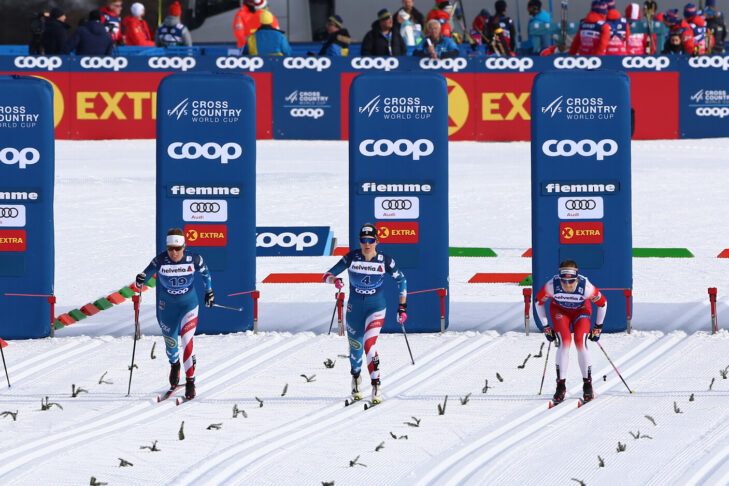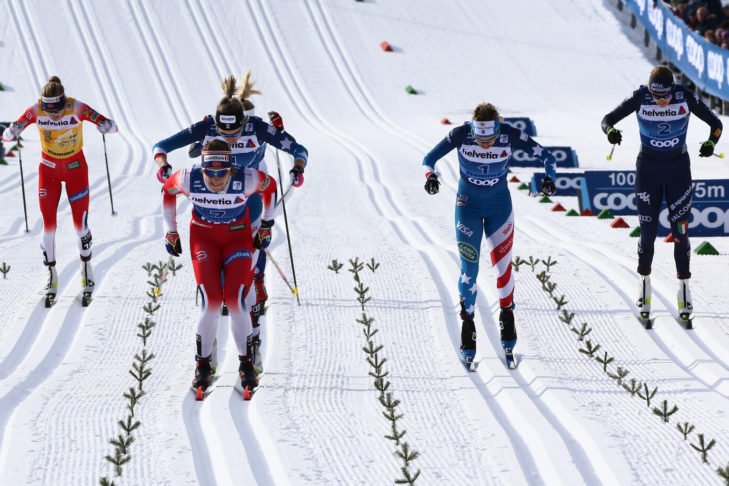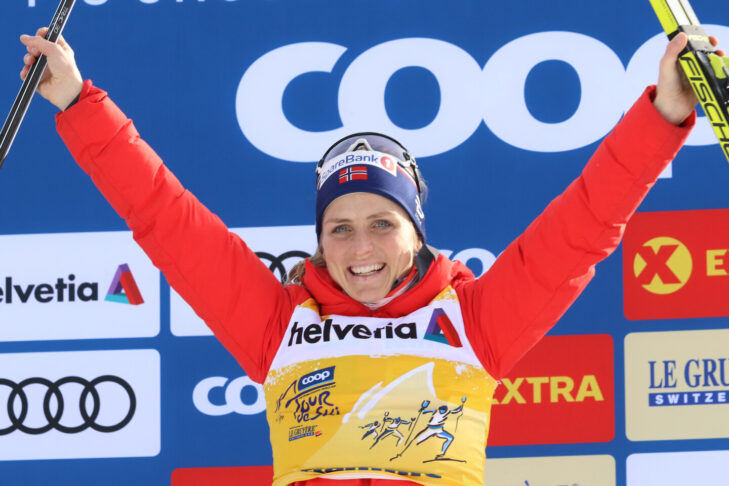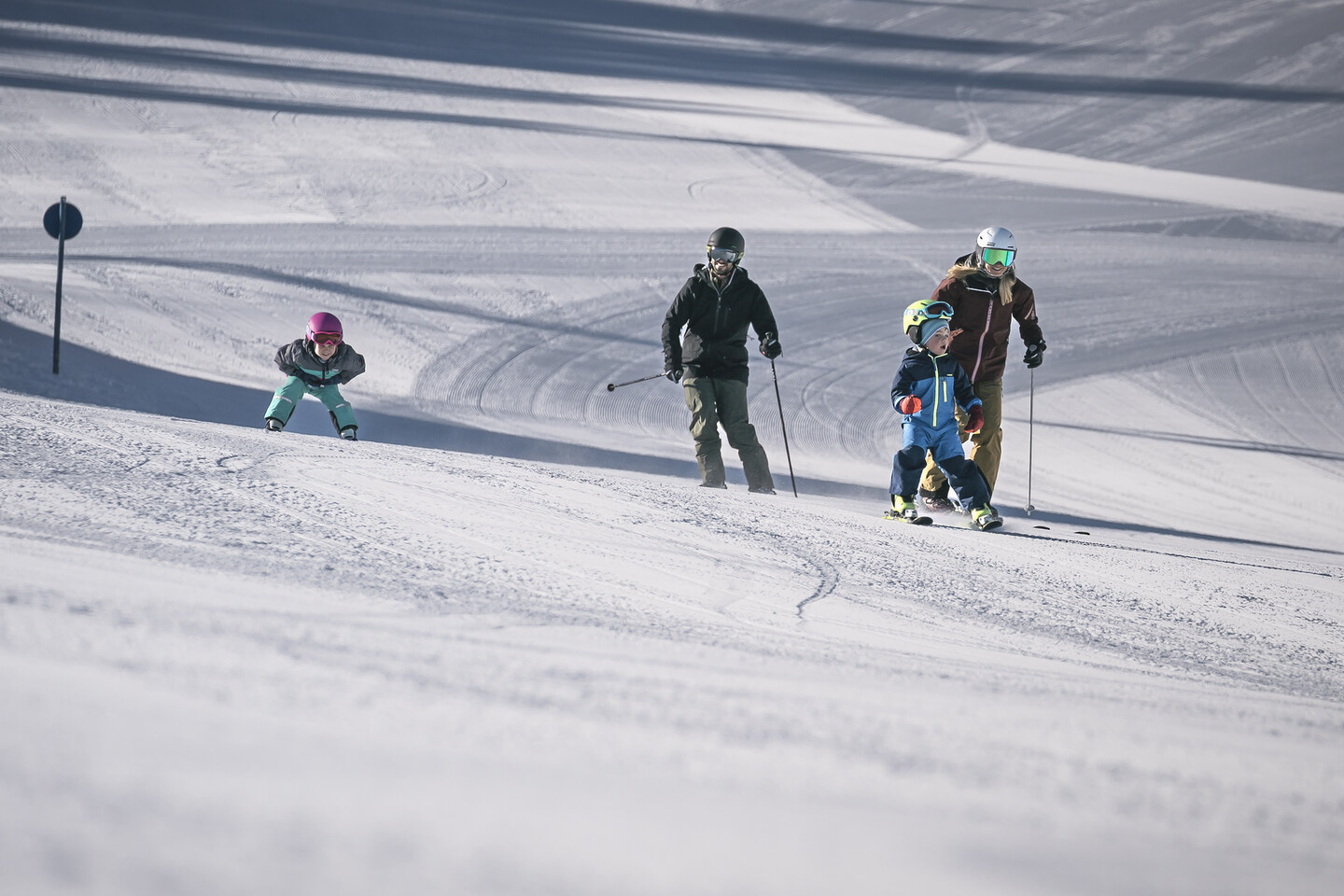There is hardly any other race in the Cross-Country World Cup to which the motto “This is a marathon, not a sprint” applies as well as it does to the Tour de Ski. Every year around New Year’s Eve, the top athletes in Nordic skiing give their all in several stages. Last season, Johannes Høsflot Klæbo and Therese Johaug (both Norway) demonstrated this impressively. They were crowned king and queen of the cross-country skiers at the end of the now world-famous climb. Reason enough for SnowTrex to explain the fascination of the “Tour de Ski” and introduce the athletes who have left their mark on this competition in the past.
The stages of the Tour de Ski 2025/2026 at a glance
| Date | Location | Discipline | Technique |
|---|---|---|---|
| 28.12.2025 | Dobbicaco (Italy) | Sprint | Freestyle |
| 29.12.2025 | Dobbicaco (Italy) | 10 km Individual | Classic |
| 31.12.2025 | Dobbicaco (Italy) | 5 km Mass Start | Freestyle |
| 01.01.2026 | Dobbicaco (Italy) | 15 km Pursuit | Classic |
| 03.01.2026 | Val di Fiemme (Italy) | Sprint | Classic |
| 04.01.2026 | Val di Fiemme (Italy) | 10 km Final Climb | Freestyle |
Please also note that by using our services and integrating the YouTube API Services, the YouTube Terms of Service and the YouTube API Services Terms apply and your use of our website is deemed to be acceptance of these terms.
→ Plan your Alpine getaway and find the best deals in Dobbicaco and in Val di Fiemme with SnowTrex
The history of the Tour de Ski
The way in which the Tour de Ski made it onto the cross-country skiing World Cup calendar in the 2006/07 season can be described as curious. Two years earlier, in the late summer of 2004, two men met in a sauna in Norway. A few weeks earlier, the world’s most famous cycling race, the Tour de France, had finished in Paris. And that’s why the two men were now discussing it in the bathtub. In particular, Jürg Capol and his host, the Norwegian Vegard Ulvang, the multiple Olympic cross-country skiing champion and the head of the International Ski Federation (FIS) had an idea. The introduction of a multi-day stage race in the snow.
The advantages of such a tour were immediately obvious to both of them. Because to select the most complete cross-country skiers among the athletes from the World Cup, they should not only have to compete in their specialised disciplines such as distance races or sprints. As with the Tour de France, in which the participating professional cyclists have to prove their versatility day after day over three weeks, the duo also envisaged this for the cross-country skiers. Instead of flat stages, mountain top finishes and time trials, the Tour de Ski would include sprint, pursuit, and mass start races in both the classic and freestyle styles.
The proposal, which Capol also forwarded to the official committees of the FIS, was so well received that the world federation finally included the multi-day stage race in the World Cup calendar for the 2006/07 season. However, the subsequent planning for the first edition of the Tour de Ski was relatively bumpy. For one thing, another of Ulvang’s ideas fell through. He wanted to organise a tour project, not only in the Alps. He also wanted to organise a tour in the Barents region between Norway, Sweden, Finland, and Russia.
In Austria and Switzerland, too, enthusiasm for the stage race for cross-country skiers was initially limited. As no organisers could be found there for 2006, the tour was initially supposed to start in Nové Město in the Czech Republic. However, due to a lack of snow, the athletes travelled directly to Munich at short notice. The 3rd stage was actually scheduled for 31 December 2006. Instead of a normal sprint, however, it became the historic prologue of the very first Tour de Ski.
How the Tour de Ski runs
To keep cross-country skiers motivated to complete the Tour de Ski, no World Cup points are awarded for the stages themselves. Only the time achieved counts. This is added to the total time after each stage. Intermediate sprints in the individual races award bonus seconds to the fastest skiers, giving them a further time advantage over their competitors. However, the biggest incentive for a good placing in the final Tour de Ski rankings is the prize money. After the last stage, the winners not only get to keep the iconic yellow jersey of the overall leader, they also receive 80.000 Euro each. A total of over 774.000 Euro will be distributed during the 2025/2026 Tour. The prize money is graded according to placement, so even athletes in 20th place can look forward to over 1.500 Euro.
And the World Cup points, which are still distributed at the Tour de Ski, are a big chunk for the final position in the overall ranking. For the winner with the fastest overall time, this means a whopping 300 points for the battle for the overall World Cup. For comparison: 100 points are awarded for winning a normal individual race in the World Cup. And places 2 to 50 in the Tour de Ski overall standings don’t go away empty-handed, either. In descending order, the placed athletes are also rewarded with corresponding World Cup points.
Please also note that by using our services and integrating the YouTube API Services, the YouTube Terms of Service and the YouTube API Services Terms apply and your use of our website is deemed to be acceptance of these terms.
The organisation of the Tour de Ski competitions varies from year to year. For one thing, there is no fixed number of stages, as is usual in the Tour de France. The number of stages has always fluctuated between 6 and 9 races. To minimise the stress of travelling, the organisers of the Tour de Ski usually try to decide on three venues where the stages will take place. In the early years, the Tour always opened with a prologue. Here, the athletes set off individually at 30-second intervals on an almost 5-kilometre cross-country skiing circuit.
After the first editions of the Tour, however, a sprint race replaced the prologue. In this format, six cross-country skiers compete against each other in a heat. The two athletes who cross the finish line first after just under 1.5 kilometres then move on to the next round. Before, the winner is determined in the final of the best six.
To uphold the idea of the two “fathers” of the Tour de Ski, Jürg Capol and Vegard Ulvang, the stages are largely divided into distance races. This is intended to reward the versatility of the cross-country skiers. As in the World Cup, the daily stages will also be run in the classic technique or freestyle. Mostly over the usual distances such as 10 km or 15 km. There are also other sprint races. The ultimate challenge for the cross-country skiers, however, is the final stage. It is unrivalled on the World Cup calendar. Since the first Tour de Ski, the so-called Final Climb in Val di Fiemme has been held here every year.
At 10 kilometres, the total distance of the section is still within the absolute limits for the pros. However, the last 3.6 kilometres are unique. Instead of a normal cross-country ski trail, the route here goes up a ski slope. From the valley to Alpe Cermis, the participants have to push themselves to their absolute limits once again. And, for the most part, even beyond. At the steepest point, the cross-country skiers have to conquer a gradient of 28 per cent. To keep the strain within limits by allowing the athletes to run parallel to the slope several times, there are also bends built into the route.
The most successful female athletes in the Tour de Ski
| Overall Victories | Name | Nationality | Tour de Ski (Years) |
|---|---|---|---|
| 4 | Justyna Kowalczyk | Poland | 2009/10, 2010/11, 2011/12, 2012/13 |
| 4 | Therese Johaug | Norway | 2013/14, 2016, 2019/20, 2024/25 |
| 2 | Virpi Kuitunen | Finland | 2006/07, 2008/09 |
| 2 | Heidi Weng | Norway | 2016/17, 2017/18 |
| 2 | Jessica Diggins | USA | 2021, 2023/24 |
| 1 | Charlotte Calla | Sweden | 2007/08 |
| 1 | Marit Bjørgen | Norway | 2015 |
| 1 | Ingvild Flugstad Østberg | Norway | 2018/19 |
| 1 | Natalya Nepryayeva | Russia | 2021/22 |
| 1 | Frida Karlsson | Sweden | 2022/23 |
The most successful athletes in the Tour de Ski
| Overall Victories | Name | Nationality | Tour de Ski (Years) |
|---|---|---|---|
| 4 | Dario Cologna | Switzerland | 2008/09, 2010/11, 2011/12, 2017/18 |
| 4 | Johannes Høsflot Klæbo | Norway | 2018/19, 2021/22, 2022/23, 2024/25 |
| 2 | Lukáš Bauer | Czech Republic | 2007/08, 2009/10 |
| 2 | Martin Johnsrud Sundby | Norway | 2013/14, 2016 |
| 2 | Alexander Bolshunov | Russia | 2019/20, 2021 |
| 1 | Tobias Angerer | Germany | 2006/07 |
| 1 | Alexander Legkov | Russia | 2012/13 |
| 1 | Petter Northug | Norway | 2015 |
| 1 | Sergey Ustiugov | Russia | 2016/17 |
| 1 | Harald Østberg Amundsen | Norway | 2023/24 |
As befits top international cross-country skiing, the dominant nation in the Tour de Ski is of course Norway. However, the motherland of Nordic skiing had to wait a whole seven years for its first overall victory after the first edition of the stage race in 2006/07. In the 2013/14 Tour, however, the Norwegians achieved total success in both the women’s and men’s races. This is the only time in the history of the Tour de Ski that athletes from the same country have taken the top three positions in the overall standings!
However, the first Tour de Ski was won by a German man. Tobias Angerer triumphed in the premiere, while Virpi Kuitunen took the first title in the women’s competition. The Finnish athlete repeated the feat two years later, before Justyna Kowalczyk began her dominance in the women’s competition. She is the only athlete to date to have won the Tour de Ski four times in a row between 2009 and 2013. With four titles, Therese Johaug, who became the first Norwegian woman to win the Tour in 2014, drew level with the Polish athlete in 2025. The number one cross-country skiing nation also has to share the title of record winner. Currently, it goes not only to Johannes Høsflot Klæbo, but also to Switzerland’s Dario Cologna. The Swiss athlete triumphed in 2009, 2011, 2012 and then again in 2018. This means that the two have won a total of four times, just like Kowalczyk and Johaug.
However, Norway still reigns supreme in two other important Tour de Ski categories. With a total of 15 overall victories in the men’s and women’s competitions, no other nation has won the prestigious stage race as often. Russia ranks second with five Tour victories, ahead of Switzerland and Poland in third place with four overall victories each. At the top of the table with the most stage wins (13) in the history of the Tour de Ski is another Norwegian, Petter Northug, in the men’s competition. And in the women’s competition, Therese Johaug now leads the way with 16 stage wins.
FAQs about the Tour de Ski
How did the Tour de Ski come about?
Jürg Capol, the former head of cross-country skiing at the FIS World Ski Federation, and Vegard Ulvang, the Norwegian 1992 Olympic cross-country skiing champion, are regarded as the fathers of the Tour de Ski. During a sauna session together at Ulvang’s house in Maridalen in 2004, the two men discussed a multi-day stage race modelled on the Tour de France and the possibility of implementing this in cross-country skiing. Their idea was so well received by the FIS decision-making bodies that the first Tour de Ski was actually organised at the turn of the year 2006/07.
When does the Tour de Ski take place?
Just like the ski jumping Four Hills Tournament, the Tour de Ski always takes place around the turn of the year. The earliest start date of a Tour de Ski was 27 December 2008, when the first of seven stages was held in Oberhof and the last stage was scheduled for 4 January 2009 in Val die Fiemme. In contrast, the 2015 Tour de Ski started later than ever before on 3 January in Oberstdorf. The same applied to the final stage, which ended on 10 January 2015 as the Final Climb on Alpe Cermis.
Where does the Tour de Ski end?
Since its first edition in 2006/07, the Tour de Ski has always ended with a unique race: the Final Climb. The starting point is always the cross-country stadium in Val die Fiemme. From there, the first 5.4 kilometres of the 9-kilometre route are relatively flat at first, before the trail finally turns left and ends there. The last 3.6 km are then tackled on the up to 28 per cent steep ski slope up to Alpe Cermis.
Who has won the Tour de Ski the most times?
The record winners of the Tour de Ski are Switzerland’s Dario Cologna and Norway’s Johannes Høsflot Klæbo. The two Olympic cross-country skiing champions have each won a total of four editions of the stage race. Cologna in 2008/09, 2010/11, 2011/12 and 2017/18, Klæbo in 2018/19, 2021/22, 2022/23 and 2024/25. In the women’s competition, Poland’s Justyna Kowalczyk and Norway’s Therese Johaug also have four overall victories in the Tour de Ski to their names. The former even won four times in a row between 2009 and 2012.
Which locations does the Tour de Ski pass through?
Throughout the history of the Tour de Ski, the stage race has stopped in a total of eleven locations in four different countries. In Germany, it was Oberhof, Munich and Oberstdorf, plus two stops in the Czech Republic with Prague and Nové Město and three stops in Switzerland with Lenzerheide, Val Müstair and Davos. Italy then played host to several stages in Dobbiaco, Asiago and Val di Fiemme, with Val di Fiemme being the only stage location to have taken part in every single edition of the Tour de Ski to date.
How many stages does the Tour de Ski have?
The Tour de Ski has been organised as part of the Cross-Country World Cup since the 2006/07 season. Since then, the number of stages has fluctuated between 6 and 9. The most stages were run in the 2011/12 edition of the Tour de Ski, when a total of nine stages were on the programme in Oberhof, Oberstdorf, Toblach and Val die Fiemme. The fewest planned stages were in the 2021/22 edition of the Tour de Ski when only six stages were to be completed. The same applied to the 2006/07 and 2017/18 editions, where only six stages were completed due to several cancellations.
What can the athletes win at the Tour de Ski?
For cross-country skiers, the Tour de Ski offers not only extra prize money but also many World Cup points. The overall winners in the women’s and men’s competitions can each look forward to a winner’s cheque for 80,000 Euro, while the runners-up will receive 55,000 Euro and the third-placed competitors 40,000 Euro. In addition, a stage victory is rewarded with 3,000 Euro. The winners of the Tour de Ski overall classification will also receive 300 additional World Cup points, while 3 points are awarded for the battle for the big crystal globe down to 50th place.





